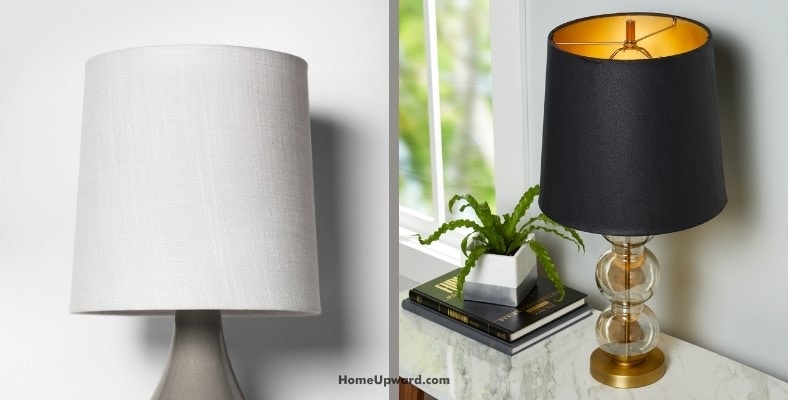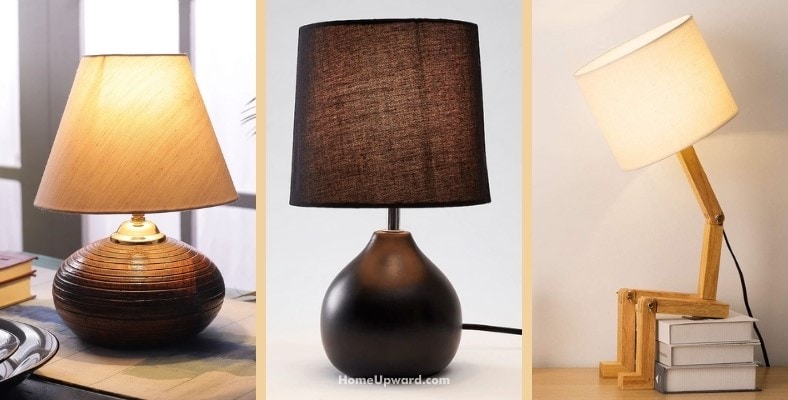Contents
What Type of Lamp Shade Gives the Most Light?
While lamps can serve many purposes in a room, the most notable is that of shedding light. And when it comes to lighting a room well, there are many factors to consider: color, material, size, shape, and more.
The Ideal Lamp Shade for Lighting an Entire Room
Which lamp shade gives best light? Overall, white, translucent shades made of thinner material and wider shapes will provide the best lighting in a room.
To give your lamp its best chance to shine for the entire room, you’ll need a shade that’s sizable enough and fits the style of the lamp and the decor of the room.
White vs Black Shade Effects
While white shades are great for magnifying light and providing bright light suitable for lighting a room or task lighting, each end of the color spectrum can create a different effect within a space.
White is certainly a more traditional choice that works to brighten and modernize a space. On the other hand, black makes a more opaque lamp shade for a softer, more ambient light effect with funneled and directed light.
Black lamp shades funnel light because they let only a small amount of light pass through the shade itself, directing most of the light to be cast from the top and bottom of the shade.
While this is great for accent lighting, it isn’t the most efficient way to light an entire room.
Do Lamp Shades Make the Light Brighter?
Although lamp shades have become an almost inseparable fixture from lamps themselves, they do not add more light to the room.
The function of a lamp shade is to protect the eye from the bright glare of an unprotected bulb, which in some cases can be irritating and distracting and in others can even be harmful.
What Size and Shape Should Your Lamp Shade Be?
The size and shape of your lamp shade should fit in with the decor theme of your room and add to the continuity of the room’s design. You can use transitional lamps this way, for example..
With maximum lighting in mind, you can choose a lamp shade that makes your room brighter as well as more cohesive.
Using Shade Proportion as a Guide
A good rule of thumb to use when deciding the size of your shade is to match it to the size of your lamp base. For example, if your lamp has a large, rounded bottom, a shade that is no larger in diameter than the base creates balance and symmetry.
Shade Style
Using the proportion guide can also help you narrow down which lamp shade style will serve your design vision the best. Each type lends itself to a different decor style: drum shades seem more modern, while bell shades and empire shades are more traditional.
Additionally, each style emits light in a different way. Styles that have wide openings for both top and bottom will cast more light than ones with narrow openings.
Considering Placement
Consider where you’ll be placing your lamp within the room. If you’re using a floor lamp that will be shedding light on a taller level, then choosing a shade with a wide opening at the bottom will cast light downwards, creating a cozy feeling.
However, the same lamp used with a shade that casts the majority of the light upwards through a sizeable upper opening will direct the eye upwards, make the room seem larger, and give a brighter effect.
Considering Safety
Most important of all when you are trying to create a bright effect within a room is safety. Make sure to always pair the appropriate lightbulb called for by the lamp’s manufacturer.
If you use a high-wattage bulb, you’ll need a more prominent shade to provide adequate space and ventilation for safe use since these bulbs emit more heat than other kinds.
An excellent way to tell if your shade is large enough for the lightbulb in use is to turn the lamp on, wait for five minutes, and then place your hand at the top opening of the shade. If it feels hot, you should use a larger shade with a wider top opening for better ventilation.
How Do You Make Good Room Lighting?
Use bright, light colors within the decor and on the walls to help reflect lamp light best. Mirrors and other reflective materials will also help to magnify the light from your lamps and spread it around the room.
Place your lamps in strategic places around the room and near reflective surfaces, like mirrors and white objects, to help brighten up the room and keep it as well-lit as possible.
Do Lamp Shades Need to Match the Room?
While lampshades that match a room can create continuity, your shade choice comes down to your desired style and effect.
If you have a more traditional design sense, adding traditional shades within the room will likely make you the most satisfied.
However, if you have a more eclectic style, then choosing shades in a contrasting type or color can help add visual interest and personality to your decor.
Should All Lamp Shades in a Room Match?
Matching lamp shade colors throughout the room will achieve a more traditional and organized style. Mixing and matching shades, though, can help the space feel more lived-in and more unique.
Still, lamp shades should complement each other for a visually pleasing room overall even if they don’t match. Using two different shades that compete for attention will make your design clash and can be distracting.
How Many Lamps Can You Have in a Room?
Since many rooms also have overhead lighting, you can add as many lamps as needed to make the room as bright as you wish. A good rule of thumb is to have four lighting sources to keep a room well lit.
Can You Use a Lamp Without a Shade?
For especially dark rooms, adding a shade to a lamp can significantly reduce the amount of light it casts.
Although using a lamp without a shade can cause strain on the eyes, certain low-wattage bulbs, especially Edison bulbs, are not only safer for the eyes but are visually pleasing and can fit into the decor of most rooms.








